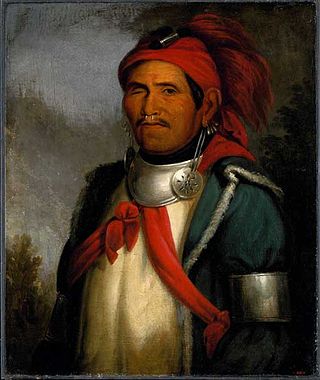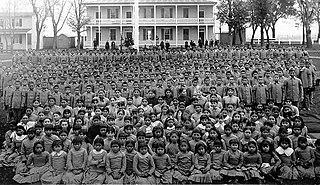Related Research Articles

Miami County is a county located in east-central Kansas and is part of the Kansas City metropolitan area. Its county seat and most populous city is Paola. As of the 2020 census, the county population was 34,191. The county was named for the Miami tribe.
Pink is a town in Pottawatomie County, Oklahoma, United States, and is part of the Oklahoma City Metropolitan Area. The only town in the United States bearing this name, Pink lies within the boundaries of the Citizen Potawatomi Nation. The population was 2,091 at the time of the 2020 Census, which is 1.6% above the 2010 census figure of 2,058, which itself was a 76.7% increase from the figure of 1,165 in 2000.

Shawnee is a city in and the county seat of Pottawatomie County, Oklahoma, United States. The population was 29,857 in 2010, a 4.9 percent increase from the figure of 28,692 in 2000. The city is part of the Oklahoma City-Shawnee Combined Statistical Area and the principal city of the Shawnee Micropolitan Statistical Area.

The Shawnee are a Native American people of the Northeastern Woodlands. Their language, Shawnee, is an Algonquian language.

Belva Ann Bennett Lockwood was an American lawyer, politician, educator, and author who was active in the women's rights and women's suffrage movements. She was one of the first women lawyers in the United States, and in 1879 she became the first woman to be admitted to practice law before the U.S. Supreme Court. Lockwood ran for president in 1884 and 1888 on the ticket of the National Equal Rights Party and was the first woman to appear on official ballots. While Victoria Woodhull is commonly cited as the first woman to run for president, she was not old enough to be elected, unlike Lockwood.

The Shawnee Tribe is a federally recognized Native American tribe in Oklahoma. Formerly known as the Loyal Shawnee, they are one of three federally recognized Shawnee tribes. The others are the Absentee-Shawnee Tribe of Indians of Oklahoma and the Eastern Shawnee Tribe of Oklahoma.

Isaac McCoy was an American pioneer and Baptist missionary among the Native Americans in what became the states of Indiana, Michigan, Missouri, and Kansas.

Cattle drives were a major economic activity in the 19th and early 20th century American West, particularly between 1850s and 1910s. In this period, 27 million cattle were driven from Texas to railheads in Kansas, for shipment to stockyards in St. Louis and points east, and direct to Chicago. The long distances covered, the need for periodic rests by riders and animals, and the establishment of railheads led to the development of "cow towns" across the frontier.

Johnston Lykins was a pioneering Baptist missionary to Native American tribes, and a founding civic booster in the frontier boomtowns of West Port and Kansas, Missouri, which combined and became Kansas City, Missouri.

American Indian boarding schools, also known more recently as American Indian residential schools, were established in the United States from the mid-17th to the early 20th centuries with a primary objective of "civilizing" or assimilating Native American children and youth into Anglo-American culture. In the process, these schools denigrated Native American culture and made children give up their languages and religion. At the same time the schools provided a basic Western education. These boarding schools were first established by Christian missionaries of various denominations. The missionaries were often approved by the federal government to start both missions and schools on reservations, especially in the lightly populated areas of the West. In the late 19th and early 20th centuries especially, the government paid Church denominations to provide basic education to Native American children on reservations, and later established its own schools on reservations. The Bureau of Indian Affairs (BIA) also founded additional off-reservation boarding schools. Similarly to schools that taught speakers of immigrant languages, the curriculum was rooted in linguistic imperialism, the English only movement, and forced assimilation enforced by corporal punishment. These sometimes drew children from a variety of tribes. In addition, religious orders established off-reservation schools. In October 2024, U.S. President Joe Biden issued an official apology on behalf of the federal government for the abuse suffered in these boarding schools. In his apology, Biden discusses the history of boarding schools and blames the government for not apologizing sooner. He recognizes this kind of apology had never been issued before and addresses it to a crowd of Indigenous people.

Ruthe Blalock Jones is a Delaware-Shawnee-Peoria painter and printmaker from Oklahoma.
Diane MacDonald Barz was an American judge. In 1978, she became the first female Montana District Court judge. She was also the first woman to serve as a member of the Montana Supreme Court, a position she held from September 1989 to 1991. She also served as an assistant United States attorney from 1991 to 1994.
Emily Eva Mullenger Sloan became the first woman elected to the office of county attorney in Montana in 1924. She won her election as County Attorney in Carbon County, Montana by 33 votes. She was the 22nd female attorney in Montana.

Alma Dorothy Bell Wilson was an Oklahoma attorney who was appointed as the second female district judge in the state of Oklahoma in 1975. In 1982, she was elevated as the first woman to serve on the Oklahoma Supreme Court and between 1995 and 1997 was the first woman chief justice. Wilson was honored by many awards in her lifetime including induction into the Oklahoma Women's Hall of Fame, the Oklahoma Hall of Fame and was named Appellate Judge of the Year in both 1986 and 1989.
Doris Swords Poppler was an American attorney who served as the United States Attorney for the District of Montana from 1990 to 1993.
Mary Frances Garrigus (1891-1918) was Montana's first Native American female lawyer.
William Henry Twine was an African-American lawyer and newspaper publisher who settled in Oklahoma. Twine is noted for having published the Muskogee Cimeter in Muskogee, Oklahoma. He was among the earliest African-American attorneys to practice in modern-day Oklahoma.
References
- ↑ Burke, Bari R. (4 February 2016). "Early Native American Women Lawyers (or students of law)". Montana's Early Women Lawyers: Trail-Blazing, Big Sky Sisters-in-Law. Retrieved 4 June 2020.
- ↑ Weatherford, Doris (2012-01-20). Women in American Politics: History and Milestones. SAGE. ISBN 9781608710072.
- ↑ The Law Student's Helper. Collector Publishing Company. 1898.
- 1 2 Burke, Bari R. (2016-02-04). "Early Native American Women Lawyers (or students of law)". Montana's Early Women Lawyers: Trail-blazing, Big Sky Sisters-in-Law. Retrieved 2019-08-24.
- ↑ The Bar. West Virginia Bar Association. 1896.